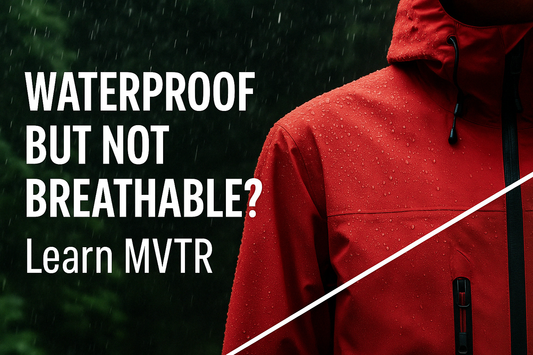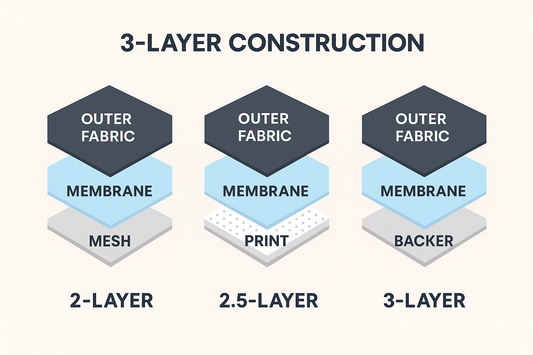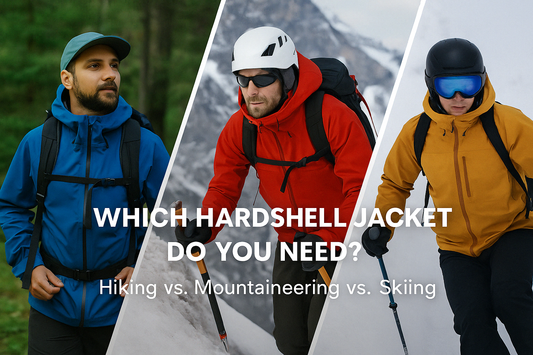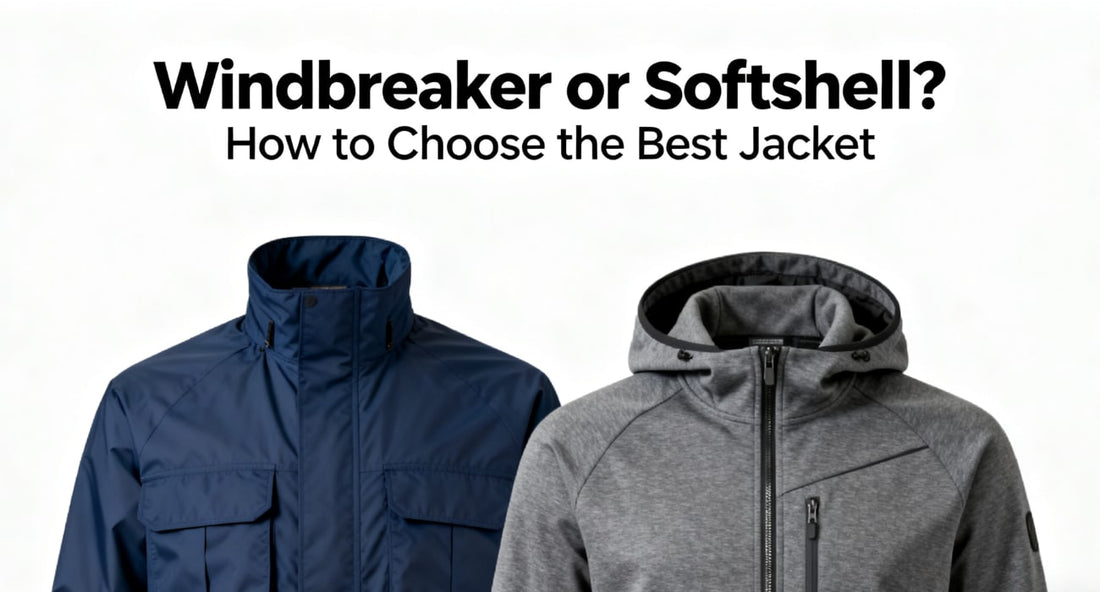
Windbreaker or Softshell? How to Choose the Best Jacket
Share
When it comes to outerwear, few choices cause as much confusion as the windbreaker versus the softshell. Both promise weather protection and lightweight comfort, yet they serve slightly different needs — one favors agility and packability, the other durability and warmth.
This Clothing Comparison breaks down the real differences between windbreakers and softshells — how they perform, when to wear each, and which one truly fits your lifestyle.
What is a Windbreaker?
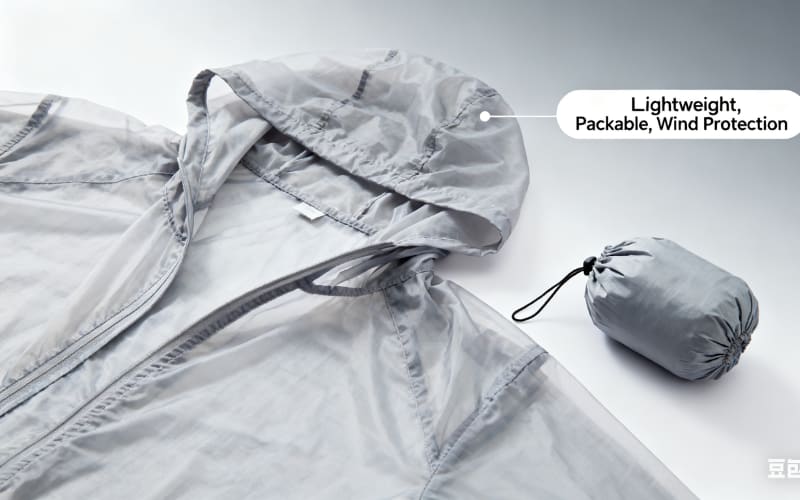
A windbreaker is a lightweight, packable jacket designed to block wind. It is often made from nylon or polyester and offers minimal insulation, making it ideal for cool, windy days. A windbreaker’s primary function is to shield the wearer from wind without adding too much warmth or weight.
Pros:
-
Wind Protection: Effectively blocks wind, keeping you warm in windy conditions.
-
Lightweight: Comfortable and easy to wear without feeling bulky.
-
Breathable: Allows moisture to escape, making it ideal for active outdoor use.
-
Compact: Easy to pack and carry, perfect for travel.
- Versatile: Great for outdoor activities and casual wear.
Cons:
-
Limited Warmth: Not suitable for very cold conditions without additional layers.
-
Limited Waterproofing: Offers some water resistance but not fully waterproof in heavy rain.
-
Durability: Light fabric can wear down more quickly in rough conditions.
What is a Softshell?
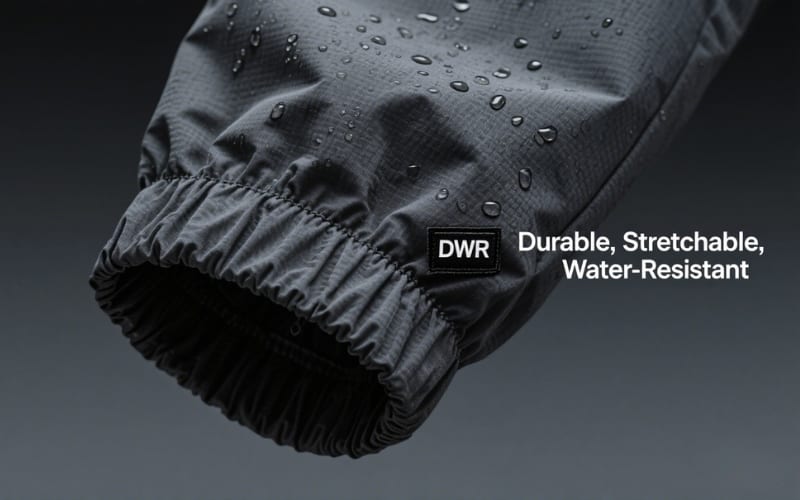
A softshell jacket is a versatile piece of outdoor gear designed for moderate weather conditions. Made from woven fabrics like nylon or polyester, it offers a balance of warmth, breathability, and flexibility. The outer layer is typically treated with a durable water-repellent (DWR) finish, making it resistant to light rain and snow.
Pros:
-
Versatile Protection: Provides a good balance of wind resistance, water resistance, and breathability.
-
Comfort and Flexibility: Made from stretchy materials, offering enhanced mobility and comfort.
-
Lightweight: Easier to move in and carry, making it suitable for active use.
-
Breathable: Allows moisture and heat to escape, keeping you comfortable during intense activities.
-
Durable: Constructed from tough, abrasion-resistant materials, ensuring long-lasting performance in rugged environments.
Cons:
-
Limited Waterproofing: Not fully waterproof, and can become soaked in heavy rain.
-
Less Insulation: May not provide enough warmth in very cold weather without layering.
- Not Ideal for Extreme Conditions: Less effective in harsh weather like heavy rain or snow.
What Is the Difference between a Windbreaker and a Softshell Jacket?
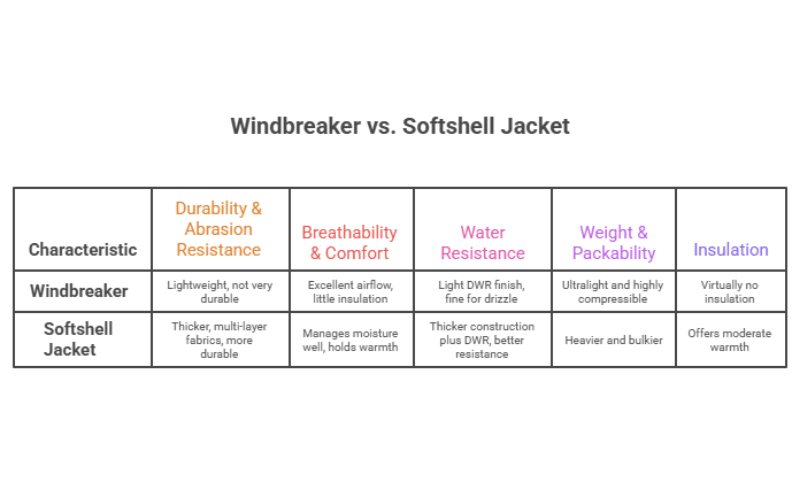
Durability & Abrasion Resistance
-
Windbreaker: Made from thin, single-layer nylon or polyester—lightweight but not very durable. The fabric scuffs, snags, and can tear in rough environments, especially during rock scrambles or bushwhacking.
-
Softshell: Built from thicker, multi-layer, higher-denier fabrics for markedly better durability and abrasion resistance. Often reinforced at high-wear zones (shoulders, elbows), making it a solid choice for climbing, rugged hikes, and dense forest travel.
Breathability & Comfort
-
Windbreaker: Excellent airflow makes it a good match for high-intensity efforts like running or fast hiking. It helps sweat evaporate quickly, but offers little insulation, so it won’t keep you warm in cold or blustery conditions without layers underneath.
-
Softshell: Not as airy, but manages moisture well and holds warmth. Suited to moderate activity—especially in cooler weather—where comfort and wind protection matter over maximum ventilation.
Water Resistance
-
Windbreaker: Typically has a light DWR (durable water repellent) finish—fine for drizzle or brief showers. Without a waterproof membrane or sealed seams, performance drops off in steady or heavy rain.
-
Softshell: Thicker construction plus DWR gives better resistance. While not fully waterproof, it handles moderate rain or light snow for longer, making it more dependable in damp conditions.
Weight & Packability
-
Windbreaker: Ultralight (about 150–250 g) and highly compressible—ideal for fast missions, travel, or as an emergency layer that takes almost no space.
-
Softshell: Heavier and bulkier (about 400–600 g). Packs down reasonably but not tiny; better for trips where you’ll wear it most of the day and need lasting performance.
Insulation
-
Windbreaker: Virtually no insulation; primarily a wind shield. Works in mild weather or as an outer layer over warm midlayers, but won’t retain body heat on its own.
- Softshell: Offers moderate warmth—often with a fleece or brushed backing—balancing insulation and breathability without bulk. Well suited to cooler conditions and steady, moderate-intensity activities.
When to Choose a Windbreaker
Choose a windbreaker when you need simple wind protection with almost no weight.
-
Weather: 8–20 °C (46–68 °F), dry or just mist/drizzle. Steady breeze on ridgelines, beach walks, early-morning runs.
-
Activity: Fast hiking, running, cycling, city commuting. Lots of movement, short stops.
- Carry: Packs to fist size (think a tennis ball–apple). Lives in the bottle pocket of your pack.
When to Choose a Softshell
Choose a softshell when you want light warmth, tougher fabric, and all-day comfort.
-
Weather: 0–10 °C (32–50 °F), on-off showers, light snow, steady wind. Too warm for a puffy, not wet enough for a full rain shell.
-
Activity: Backpacking with scrambles, multi-pitch days, via ferrata, shoulder-season bikepacking, ski touring in cold, dry air.
- Carry/Wear: Heavier than a windbreaker, but you’ll wear it most of the day. Shrugs off brush and rough rock.
Top Recommendations: Best Windbreakers and Softshell Jackets for 2025
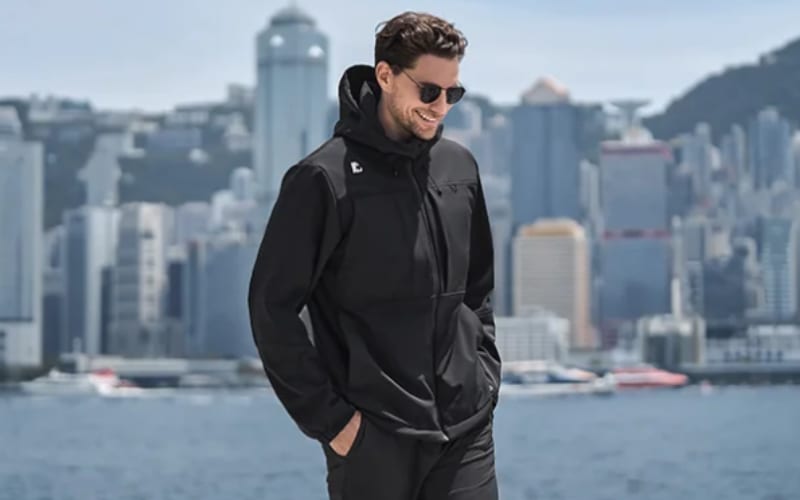
What Is the Best Windproof Jacket?
1) Patagonia Houdini — lightweight, “always-pack” shell
-
Best for: Runs, fast hikes, bike commutes on breezy days.
-
Works in:10–20°C (50–68°F), dry or brief drizzle.
-
Carry weight / size: ~100–110 g; stuffs into its chest pocket (about palm size).
-
What you get: Wind-blocking nylon, basic DWR, one zip chest pocket, elastic hood/cuffs/hem.
-
Pros: Ultra-packable, quick on/off, dries fast.
-
Cons: Very thin—easy to snag; wets out in steady rain.
2) Black Diamond Distance Wind Shell — better airflow while moving
-
Best for: Trail running, fastpacking, long climbs where you stay in the jacket.
-
Works in:8–18°C (46–64°F), gusty ridgelines, light mist.
-
Carry weight / size: ~95–115 g; pocket-packable.
-
What you get: Air-permeable wind fabric, helmet-friendly hood, simple hem/cuff.
-
Pros: Breathes better than most windbreakers during hard efforts.
-
Cons: Feels cool at rest; still a thin face fabric.
Best Softshell Jacket
3) Arc’teryx Gamma LT Hoody — durable, wear-all-day layer
-
Best for: Scrambling, backpacking, rough trails, cool shoulder seasons.
-
Works in:0–10°C (32–50°F), wind, on-off showers (carry a rain shell for downpours).
-
Carry weight / size: ~450–520 g (varies by size).
-
What you get: Stretch-woven high-denier face, DWR, brushed inner feel, helmet-compatible hood, hand pockets + zip chest pocket set clear of hipbelt/harness.
-
Pros: Tough face fabric, comfortable stretch, pockets usable with a pack.
-
Cons: Heavier than a windbreaker; warm for humid, nonstop cardio.
4) Alpargali Coreshell Jacket — simple, quiet, easy to live in
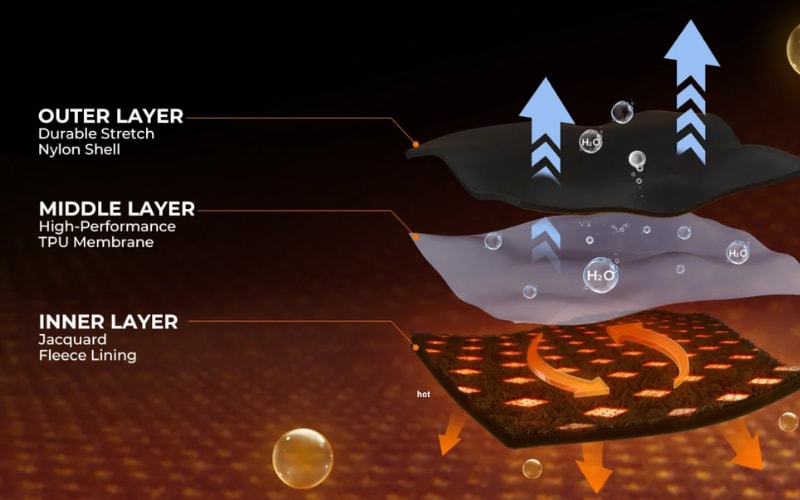
Best for: Cover windy commutes, chilly office AC, weekend park loops, and light hikes—with pockets that actually organize life.
Work in: Breezy, stop-and-go days, 5–12 °C (41–54 °F); city-to-trail use; light, on-off showers where a pure windbreaker feels chilly.
Why it stands out (in real life terms):
-
Warmer without bulk: Core Lock™ + dual-layer jacquard fleece delivers ~30% more warmth than standard fleece.
-
Weather-ready:10K waterproof / 10K breathable barrier with fluorine-free DWR resists drizzle and wind.
-
Comfort on the move: Breathable build releases heat and moisture so it doesn’t feel clammy.
-
Durable, not stiff: Stretch woven outer with 20,000 Martindale abrasion resistance; quiet hand, easy mobility.
-
Organized carry:13-pocket layout for phone, wallet, cards, passport, and small essentials—clean and secure.
-
Clean layering: Anti-static treatment, adjustable hood/cuffs/hem, smooth YKK zippers.
- Lower impact, easy care: Recycled fabrics, fluorine-free finish, machine washable.
Quick chooser
- Want the lightest wind cut and pocket-size packability? Houdini.
- Want to keep the jacket on during hard output? Distance Wind Shell.
- Need durability for rough days out? Gamma LT.
- Want one jacket that feels right from city to trail and actually organizes your carry? Alpargali CoreShell.
In this Clothing Comparison, you can clearly see how each type of jacket performs where it matters most — which one feels lighter, which offers more warmth, and which adapts better to unpredictable weather. These help you understand the real differences and choose the layer that suits your routine and environment.
The right coat should protect against the elements and adapt to everyday activities without requiring extra thought. At Alpargali, this is the focus behind every piece: integrating technical performance into styles you can wear every day.
Browse our latest outerwear collection and choose the jacket that fits your lifestyle — built for real weather and real movement.
